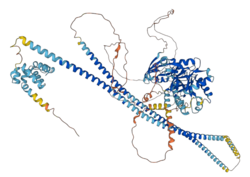Biology:CARD11
 Generic protein structure example |
Caspase recruitment domain-containing protein 11 also known as CARD-containing MAGUK protein 1 (Carma 1) is a protein in the CARD-CC protein family that in humans is encoded by the CARD11 gene.[1][2][3] CARD 11 is a membrane associated protein that is found in various human tissues, including the thymus, spleen, liver, and peripheral blood leukocytes. Similarly, CARD 11 is also found in abundance in various lines of cancer cells.[1]
Function
The protein encoded by this gene belongs to the membrane-associated guanylate kinase (MAGUK) family, a class of proteins that functions as molecular scaffolds for the assembly of multiprotein complexes at specialized regions of the plasma membrane. This protein is also a member of the CARD protein family, which is defined by carrying a characteristic caspase-associated recruitment domain (CARD). CARD11 (CARMA1) has a domain structure similar to that of CARD10 (CARMA3) and CARD14 (CARMA2) as a member of the CARD-CC family with a C terminal MAGUK domain (the so-called CARMA proteins). The CARD domain of proteins in the CARD-CC family have been shown to specifically interact with BCL10, a protein known to function as a positive regulator of NF-κB activation by recruitment and activation of MALT1. When overexpressed in cells, this protein family activates NF-κB and induces the phosphorylation of BCL10.[3]
CARD11 is critical for T cell and B cell function and is activated after T cell receptor or B cell receptor stimulation. After receptor stimulation, CARD11 is phosphorylated by PKC-θ (in T cells) or PKC-β (in B cells). The phosphorylation induces formation of filamentous CARD11 multimers that recruit BCL10 and MALT1, which in turn activates NF-κB. Loss of function mutations in CARD11 cause severe combined immunodeficiency (SCID) since the function of cells critical for adaptive immunity are disrupted.
Structure
The structure of CARD11 involves multiple domains that impact the protein's ability to activate BCL10 and NF-κB activity. CARD11 has a CARD domain, a serine-threonine rich region, is associated with the N-terminus, which is essential for NF-κB signaling activity. The region following the CARD domain is highly coiled. In deleting the CARD domain, all NF-κB signaling activity was prevented. The CARD domain on CARD11 interacts with the CARD domain on BCL10 to initiate the signaling pathway.[1]
On the C-terminus of CARD11 there is the MAGUK domain that is associated with the cell membrane. This domain is often referred to as the inhibitory domain. Protein kinase C activates CARD11 by phosphorylating serine residues within the inhibitory domain.[1][4]
Interactions
CARD11 has been shown to interact with BCL10.[5] This interaction occurs between the CARD domain on BCL10 and the CARD domain on CARD11, and results in signal propagation and NF-κB activation.[4]
References
- ↑ 1.0 1.1 1.2 1.3 "CARD11 and CARD14 are novel caspase recruitment domain (CARD)/membrane-associated guanylate kinase (MAGUK) family members that interact with BCL10 and activate NF-kappa B". J. Biol. Chem. 276 (15): 11877–82. Apr 2001. doi:10.1074/jbc.M010512200. PMID 11278692.
- ↑ "Carma1, a CARD-containing binding partner of Bcl10, induces Bcl10 phosphorylation and NF-kappaB activation". FEBS Lett. 496 (2–3): 121–7. May 2001. doi:10.1016/S0014-5793(01)02414-0. PMID 11356195.
- ↑ 3.0 3.1 "Entrez Gene: CARD11 caspase recruitment domain family, member 11". https://www.ncbi.nlm.nih.gov/sites/entrez?Db=gene&Cmd=ShowDetailView&TermToSearch=84433.
- ↑ 4.0 4.1 "Structures of autoinhibited and polymerized forms of CARD9 reveal mechanisms of CARD9 and CARD11 activation". Nat Commun 10 (3070): 3070. 2019. doi:10.1038/s41467-019-10953-z. PMID 31296852. Bibcode: 2019NatCo..10.3070H.
- ↑ "CARD11 and CARD14 are novel caspase recruitment domain (CARD)/membrane-associated guanylate kinase (MAGUK) family members that interact with BCL10 and activate NF-kappa B". J. Biol. Chem. 276 (15): 11877–82. April 2001. doi:10.1074/jbc.M010512200. PMID 11278692.
External links
- Human CARD11 genome location and CARD11 gene details page in the UCSC Genome Browser.
Further reading
- "Generation and analysis of 280,000 human expressed sequence tags". Genome Res. 6 (9): 807–28. 1996. doi:10.1101/gr.6.9.807. PMID 8889549.
- Sanger Centre, The; Washington University Genome Sequencing Cente, The (1998). "Toward a complete human genome sequence". Genome Res. 8 (11): 1097–108. doi:10.1101/gr.8.11.1097. PMID 9847074.
- "Card10 is a novel caspase recruitment domain/membrane-associated guanylate kinase family member that interacts with BCL10 and activates NF-kappa B". J. Biol. Chem. 276 (24): 21405–9. 2001. doi:10.1074/jbc.M102488200. PMID 11259443.
- "A requirement for CARMA1 in TCR-induced NF-kappa B activation". Nat. Immunol. 3 (9): 830–5. 2002. doi:10.1038/ni824. PMID 12154356.
- "CARMA1 is a critical lipid raft-associated regulator of TCR-induced NF-kappa B activation". Nat. Immunol. 3 (9): 836–43. 2002. doi:10.1038/ni830. PMID 12154360. http://nbn-resolving.de/urn:nbn:de:bsz:352-2-1mitensdcb5c25.
- "CARD11 mediates factor-specific activation of NF-kappaB by the T cell receptor complex". EMBO J. 21 (19): 5184–94. 2002. doi:10.1093/emboj/cdf505. PMID 12356734.
- "CD3/CD28 costimulation-induced NF-kappaB activation is mediated by recruitment of protein kinase C-theta, Bcl10, and IkappaB kinase beta to the immunological synapse through CARMA1". Mol. Cell. Biol. 24 (1): 164–71. 2004. doi:10.1128/MCB.24.1.164-171.2003. PMID 14673152.
- "Physical and functional interaction of CARMA1 and CARMA3 with Ikappa kinase gamma-NFkappaB essential modulator". J. Biol. Chem. 279 (33): 34323–31. 2004. doi:10.1074/jbc.M402244200. PMID 15184390.
- "PDK1 nucleates T cell receptor-induced signaling complex for NF-kappaB activation". Science 308 (5718): 114–8. 2005. doi:10.1126/science.1107107. PMID 15802604. Bibcode: 2005Sci...308..114L.
- "PKC beta regulates BCR-mediated IKK activation by facilitating the interaction between TAK1 and CARMA1". J. Exp. Med. 202 (10): 1423–31. 2005. doi:10.1084/jem.20051591. PMID 16301747.
- "Phosphorylation of the CARMA1 linker controls NF-kappaB activation". Immunity 23 (6): 561–74. 2005. doi:10.1016/j.immuni.2005.09.014. PMID 16356855.
- "Phosphorylation of CARMA1 plays a critical role in T Cell receptor-mediated NF-kappaB activation". Immunity 23 (6): 575–85. 2005. doi:10.1016/j.immuni.2005.10.007. PMID 16356856.
- "CARMA1 is required for Akt-mediated NF-kappaB activation in T cells". Mol. Cell. Biol. 26 (6): 2327–36. 2006. doi:10.1128/MCB.26.6.2327-2336.2006. PMID 16508008.
- "Nore1B regulates TCR signaling via Ras and Carma1". Cell. Signal. 18 (10): 1647–54. 2006. doi:10.1016/j.cellsig.2006.01.015. PMID 16520020.
- "Ca2+/calmodulin-dependent protein kinase II is a modulator of CARMA1-mediated NF-kappaB activation". Mol. Cell. Biol. 26 (14): 5497–508. 2006. doi:10.1128/MCB.02469-05. PMID 16809782.
 |


